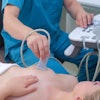CHICAGO - Poor positioning of fatty breasts and underexposure of dense breasts are among the top reasons why mammography facilities fail to receive accreditation due to unsatisfactory clinical images.
In a study reported in scientific sessions at the RSNA conference Dec. 2, researchers from the University of California, Los Angeles and Thomas Jefferson University in Philadelphia looked at the clinical image statistics for all evaluations performed by the American College of Radiology Mammography Accreditation Program in 1997. ACR-MAP reviewed images from 2,341 mammography units in that year, 1,034 (44%) of which failed their inital evaluation.
ACR-MAP looks at eight categories in evaluating clinical images: positioning, compression, exposure, contrast, sharpness, noise, artifacts and labeling. Of these, positioning was the category where the highest number of failing grades were earned, followed by exposure, compression, sharpness and contrast.
The most commonly cited positioning problem was an inadequate amount of pectoral muscle on MLO views.
A significantly higher proportion of fatty breast images failed due to positioning deficiencies, noted Dr. D.M. Farria. Conversely, a significanly higher proportion of dense breast images were affected by exposure and compression deficiencies.
"We hope that these results will be valuable for educators in planning future continuing education courses for radiologists and for radiologic technologists," said Dr. Farria, noting that "different breast compositions pose different challenges."
By Tracie L. ThompsonAuntMinnie.com staff writer
December 3, 1999


















